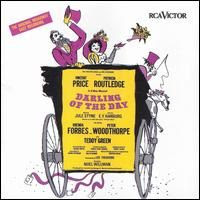Every six months, the booksellers at B&N receive what is called the “Employee Appreciation Discount” which gives us 40% off on books for a period of about a week. I was hell-bent on not buying anything, but my impulsive-compulsive whimsy took me to the computer screen to search for items of interest. One of the things I decided to do was look up some books that were later musicals or movies.
I read three of those recently (among two other books – the Strouse memoir and A Separate Peace by John Knowles): The Flower Drum Song by C.Y. Lee, The World of Henry Orient by Nora Johnson and Buried Alive by Arnold Bennett. Obviously the first was the basis for Flower Drum Song, the second, the 1967 Bob Merrill flop Henry, Sweet Henry (which came about from the popularity of the 1964 film adaptation) and my beloved 1968 disaster Darling of the Day.
As I read through the books, it fascinated me to see what the original creators came up with in terms of plot and character. Particularly FDS. In the book, the plot follows Wang Ta from his failed romance with the sluttish Linda Tow to his guilt-laden affair with the obsessive Helen Chao (who does one further than tell love to look away, she kills herself) and finally his romance with May Li, a Chinese immigrant, who is much more outspoken and not as charming as the character presented in the musical (the 2002 Hwang revisal need not apply). However, the themes of tradition and culture when juxtaposed with a generational gap (add to that the East vs. West friction), you see where Rodgers and Hammerstein found their musical. Keeping the characters and certain plot elements, they made their musical a decidedly lighter and more comic piece.
The World of Henry Orient and Buried Alive were pre-paid print on demand orders. They are books not regularly carried by the store and are non-returnable, so its got to be paid for and shipped to your home. I enjoyed that – you want a book, they print it especially for you – it’s kinda nice. Henry Orient, I think, should go onto the middle school reading lists. It’s a remarkably sophisticated coming of age story about two imaginative and quirky pubescent girls whose friendship revolves around their fascination with a second-rate pianist. However, the plot isn’t enough to carry a full-scale musical (not to mention the decision to take the relatively minor character of Lillian Kafritz and build her up with two glorious, but extraneous, showstoppers, but of course that’s what happens when you write a role for the fantastic Alice Playten).
Buried Alive is a delightful light British prose, with the farcical plot elements of a famed painter switching places with his dead valet. However, one of the major changes between Buried and Darling is the character of Priam Farll. In the book, most of his actions stem from an incredible introversion as opposed to the Henry Higgins-like disgust with British class society of the musical. Fortunately they kept the social commentary about the class society (Yip Harburg had a field day) in adaptation. However, the song “Butler in the Abbey” presents a finale that doesn’t possibly make sense. In the musical, its decided that the idea a valet has been buried in Westminster Abbey would bring ruination to England, and the final decision is to let Priam Farll go on being Henry Leek in Putney, with a decidedly Gilbertian tone. In the book, with more realism and great humor, the author playfully describes the media circus the trial creates throughout England, satirizing everyone along the way.
I’ve also started to list the books I’ve recently read under the aptly titled “A Trip to the Library” toward the right of the blog posts. Just feel like sharing!!
